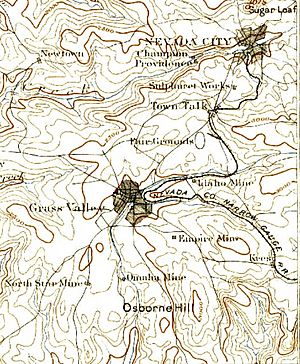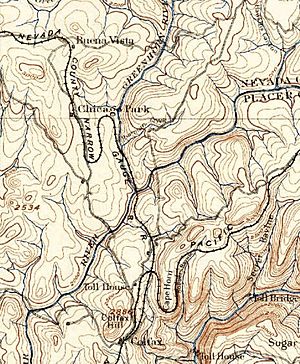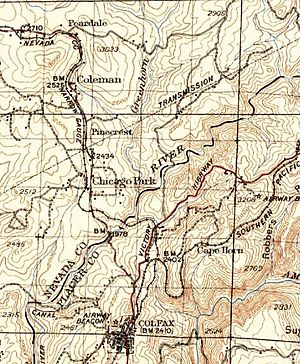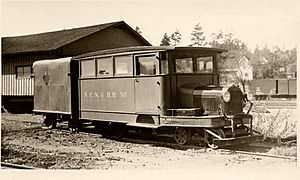Nevada County Narrow Gauge Railroad facts for kids
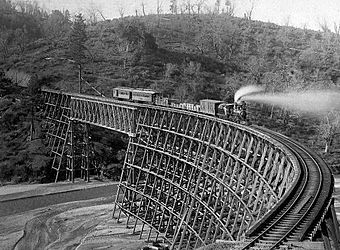
Mixed passenger and freight train on the Bear River bridge in 1895
|
|
| Overview | |
|---|---|
| Headquarters | Grass Valley, California |
| Locale | Northern California |
| Dates of operation | 1876–1942 |
| Successor | Abandoned |
| Technical | |
| Track gauge | 3 ft (914 mm) |
The Nevada County Narrow Gauge Railroad (NCNGRR) was a special train line in Northern California. It ran through Nevada County and Placer County. This railroad connected with the larger Central Pacific Railroad. People sometimes called it Never Come, Never Go as a joke.
The company that owned the railroad started on April 4, 1874. Its main office was in Grass Valley, California. After two years of building, trains began carrying people and goods in 1876. They kept running until 1943. The tracks stretched about 22.5 miles (36.2 km) from Colfax, north through Grass Valley, all the way to Nevada City. For a while, this railroad was famous for having the tallest railroad bridge in California, called the Bear River Bridge, which was built in 1908.
Contents
History of the NCNGRR
People in Grass Valley and Nevada City needed a train service. This was because of all the mining happening after the California Gold Rush. Also, companies that cut down trees wanted an easy way to get their wood to the Southern Pacific Company in Colfax.
On March 20, 1874, the California government and Governor Newton Booth said "yes" to building this railroad. It would be a 3 ft (914 mm) narrow gauge line. This meant its tracks were closer together than standard tracks. On June 20, the U.S. Congress also gave the railroad permission to build across public lands.
Building the Railroad Tracks
Building the railroad was a big job! J. H. Bates thought it would cost about $411,132. But the only company that wanted to build it, M. F. Beatty, asked for $500,000. So, they paid him that amount.
Construction started in January 1875. John Flint Kidder was the main engineer in charge. Within two months, 600 workers were busy building the railroad.
The project included building two bridges, digging two tunnels, and putting up five trestles (wooden bridges). After leaving the depot in Colfax, the tracks went north. They ran next to the Central Pacific Railroad, then crossed the Bear River into Nevada County.
One of the first stops was at a town called You Bet. This stop helped the Goodwin Drift Gravel Mine. The train then went to Chicago Park, where people grew fruits and grapes. Finally, it continued into Grass Valley.
All the train cars and engines had special Westinghouse railway brakes. Passenger cars also had Miller Platform couplers, which helped connect the cars. The first builder, Beatty, couldn't finish the project. So, another builder, J. K. Bynre, took over. The railroad was finished in the spring of 1876. The very first train from Colfax to Grass Valley ran on April 11. By May 20, the first train reached Nevada City.
Important People in the Railroad's History
The first president of the company was John C. Coleman. He was also the president of the North Star Mine. John Flint Kidder, who built the railroad, decided to stay in Grass Valley. He became the General Superintendent, which is like a manager. In 1884, he became the second president.
When Kidder passed away in 1901, his wife, Sarah, took over. This made her the first female railroad president in the entire world!
In September 1907, a new section of track was built. It was about 3.56 miles (5.73 km) long and cost $132,285. This "cut-off" made the slope of the tracks better. The next year, the Bear River Bridge was finished. By 1912, the NCNGRR was running three mixed trains (carrying both people and goods) every day, going both ways between Nevada City and Colfax. A fourth mixed train ran daily between Grass Valley and Colfax. Sarah Kidder sold her part of the railroad in 1913 and moved to San Francisco.
In 1926, Earl Taylor and his friends bought the railroad for just $1! But when World War II started, they sold it in 1942 for $251,000 to a company called Dulian Steel Products. The very last train ran on May 29, 1942.
Each passenger car had a small iron safe in the baggage area. Even though the NCNGRR carried $200,000,000 worth of gold out of Nevada County during its time, no one ever tried to rob a train!
Railroad Facts and Figures
- Length: The main track was about 22.41 miles (36.07 km) long.
- Steepest Slope: The tracks went up as much as 116 feet per mile (22 meters per km).
- Smallest Curve: Trains could turn on curves with a radius of about 302.9 feet (92.3 meters).
- Track Weight: The rails weighed about 35 pounds per yard (17 kg per meter).
- Starting Prices:
- For passengers: $0.10 for every mile traveled.
- For freight (goods): $0.20 for every ton carried per mile.
- Travel Time:
- The fastest trip was 1 hour and 40 minutes.
- Mixed trains (carrying people and goods) took about two hours.
- Average Stops: Trains usually made four stops along the way.
Locomotives (Train Engines)
These are some of the steam locomotives that pulled trains on the Nevada County Narrow Gauge Railroad:
| Number | Name | Type | Builder | Built | Acquired | Notes |
|---|---|---|---|---|---|---|
| 1 | Grass Valley | 4-4-0 | Baldwin Locomotive Works | 1875 | 1875 | Taken apart in 1936. |
| 1 | Glenbrook | 2-6-0 | Baldwin Locomotive Works | 1875 | 1936 | Sold in 1942. You can see it today at the Nevada State Railroad Museum in Carson City, Nevada. |
| 2 | Nevada | 2-6-0 | Baldwin Locomotive Works | 1875 | 1875 | Taken apart in 1933. |
| 3 | 4-4-0 | Baldwin Locomotive Works | 1877 | 1877 | Taken apart in 1916. | |
| 4 | Santa Cruz | 0-6-0 | Porter-Bell | 1875 | 1899 | Taken apart in 1916. |
| 5 | Tahoe | 2-6-0 | Baldwin Locomotive Works | 1875 | 1899 | Sold in 1940. Later given to the Nevada County Narrow Gauge Museum, where it is on display. |
| 6 | 2-6-0 | New York Locomotive Works | 1883 | 1915 | Taken apart in 1921. | |
| 7 | 4-4-0 | Baldwin Locomotive Works | 1881 | 1929 | Taken apart in 1934. | |
| 8 | 2-8-0 | Baldwin Locomotive Works | 1880/1882 | 1933 | Sold in 1942. | |
| 9 | 2-8-0 | Baldwin Locomotive Works | 1914 | 1933 | Sold in 1942. |
Other Engines
Engine 10 was built by Fate-Root-Heath Company. It only ran for the first six months of 1936. Engine 11 was built by Whitcomb Manufacturing Company. It was in service from 1936 to 1942.
Famous Passengers
Many important people rode on the Nevada County Narrow Gauge Railroad. These included presidents Ulysses S. Grant and Theodore Roosevelt. The famous singer Emma Nevada also rode the train. Even Britain's Prince Albert was a passenger!
Remembering the Railroad
One hundred years after the railroad started, a group called E Clampus Vitus put up a special historical marker. It's in Colfax at 39°6.011′N 120°57.159′W / 39.100183°N 120.952650°W. This spot was the southern end of the train line.
Today, you can visit the Nevada County Narrow Gauge Railroad & Transportation Museum. It's located near Nevada City, which was the northern end of the line. The museum helps people learn about this important part of California's history.
Images for kids


